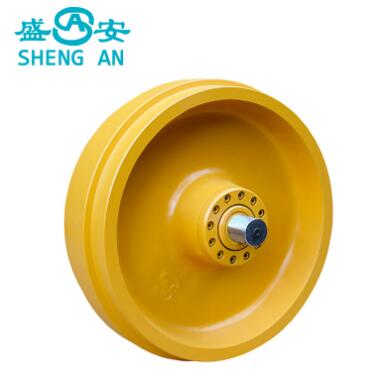A Comprehensive Guide to Idlers for Excavators
2025-01-15
Excavators are the backbone of heavy-duty construction and earthmoving operations. Every component in these machines plays a crucial role in their performance, and the idler is no exception. Often overlooked, the idler is a critical part of the undercarriage system, ensuring smooth operation and proper alignment of the tracks. In this blog, we’ll dive into the importance of idlers for excavators, their functionality, types, and tips for maintenance.
1. What is an Idler for an Excavator?
The idler is a wheel-like component located at one or both ends of the excavator's undercarriage track system. It serves several vital functions:
- Guide Tracks: Keeps the excavator’s tracks properly aligned.
- Tension Control: Maintains optimal track tension to prevent slippage or over-tightening.
- Weight Distribution: Helps evenly distribute the machine's weight across the tracks.
2. Types of Idlers for Excavators
Idlers come in different types, depending on their position and design:
- Front Idler: Located at the front of the track frame, it guides and tensions the track.
- Rear Idler: Occasionally present in certain designs, it complements the front idler.
- Carrier Idler: Positioned above the track frame in some excavators, it helps support the upper portion of the track.
3. How Idlers Work in Excavators
The idler works in conjunction with the sprockets, rollers, and track chain to ensure efficient and stable operation:
- Track Alignment: The idler keeps the tracks running smoothly along their designated path, minimizing wear and tear.
- Tensioning: It works with a tensioning mechanism, such as a hydraulic or spring-loaded adjuster, to maintain optimal track tightness.
- Absorbing Impact: Designed to endure the heavy stresses of rough terrain, the idler reduces shocks and vibrations.
Common Materials Used in Idler Construction
Excavator idlers are built to withstand extreme conditions:
- High-Strength Steel: Ensures durability and resistance to impact.
- Heat-Treated Surfaces: Improves wear resistance, especially in abrasive environments.
- Corrosion-Resistant Coatings: Protects against rust and environmental damage.
Maintenance Tips for Excavator Idlers
To keep idlers in optimal condition, follow these maintenance practices:
1. Inspect Regularly: Look for signs of wear, cracks, or alignment issues.
2. Clean Frequently: Remove debris, mud, and rocks to prevent damage.
3. Check Tension: Ensure the track tension is neither too loose nor too tight.
4. Lubricate as Needed: Some idlers may require periodic lubrication to reduce friction.
5. Replace Worn Parts: Replace idlers showing significant wear to prevent damage to the tracks or sprockets.
Selecting the Right Idler for Your Excavator
When choosing a replacement idler, consider the following:
- Compatibility: Ensure the idler matches your excavator model and specifications.
- Quality: Opt for OEM (Original Equipment Manufacturer) or high-quality aftermarket idlers.
- Warranty: Look for products with a reliable warranty for added peace of mind.
Idlers for excavators may seem like a small component, but their role in ensuring smooth, efficient, and safe operations is critical. By understanding their function, maintaining them properly, and replacing them when needed, you can maximize your excavator’s performance and longevity.
Whether you’re a contractor, machine operator, or equipment manager, paying attention to the idler is a simple yet effective way to keep your excavator running at its best.



